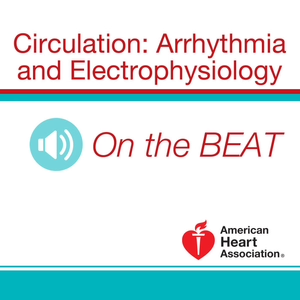
Circulation: Arrhythmia and Electrophysiology On the Beat March 2018
Circulation: Arrhythmia and Electrophysiology On the Beat03/20/18 • 80 min
Paul Wang: Welcome to the monthly podcast “On The Beat”, for Circulation: Arrhythmia and Electrophysiology. I am Dr. Paul Wang, Editor-in-Chief, with some of the key highlights from this month's issue. We'll also hear from Dr. Suraj Kapa, reporting on new research from the latest journal articles in the field.
In our first article, Adetola Ladejobi and associates studied 1,433 patients, between 2000 and 2012, who were discharged alive after sudden cardiac arrest. A reversible and correctable cause was identified in 792 patients, or 55%. A reversible cause for sudden cardiac arrest was defined as significant electrolyte or metabolic abnormality, evidence of acute myocardial infarction or ischemia, recent initiation of antiarrhythmic drug, or illicit drug use, or other reversible circumstances.
Of the 792 sudden cardiac arrest survivors, due to reversible or correctable cause, 207 or 26% of the patients received an ICD after their indexed sudden cardiac arrest. During a mean follow-up of 3.8 years, 319 or 40% of patients died. ICD implantation was highly associated with a lower all-cause mortality, p < 0.001, even after correcting for unbalanced baseline characteristics.
In subgroup analyses, only patients with sudden cardiac arrest, were not associated with myocardial infarction, extracted benefit from the ICD, p < 0.001.
The authors concluded that in survivors of sudden cardiac arrest, due to a reversible and correctable cause, ICD therapies associated with lower all-cause mortality, except if the sudden cardiac arrest was due to myocardial infarction.
Further prospect of multi-center randomized control trials will be needed to confirm this observation.
In our next study, Carlo Pappone and associates, studied 81 patients with persistent atrial fibrillation, randomized to undergo high density electrophysiological mapping, to identify repetitive regular activities, before modified circumferential pulmonary vein ablation, or modified circumferential pulmonary vein ablation alone. The primary endpoint was freedom from arrhythmia recurrence at one year.
In the 81 patients with persistent atrial fibrillation, there were 479 regions exhibiting repetitive regular activities in these patients, or 5.9 repetitive regular activities per patient. There were 232 regions in the mapping group, which consisted of 41 patients, and 247 regions in the control group, consisting of 40 patients. Overall, 39% of the repetitive regular activities were identified within pulmonary veins, whereas 61% were identified in non-pulmonary vein regions.
Mapping-guided ablation resulted in higher arrhythmia termination rate, as compared to conventional strategy, 61% vs. 30%, p < 0.007. Total RF duration, mapping, and fluoroscopy times were not significantly different between the groups. No major procedure related adverse events occurred.
After one year, 73% of the mapping group of patients were free of recurrences, compared to 50% of the control group, p = 0.03.
The authors concluded that targeted ablation of regions showing repetitive regular activities provided adjunctive benefit in terms of arrhythmia freedom at one year in treatment of patients with persistent atrial fibrillation. These findings should be confirmed by additional larger randomized multi-centered studies.
In the next article, Maciej Kubala and associates examine repolarization abnormalities in 40 patients with arrhythmogenic right ventricular cardiomyopathy, comparing extent and location of abnormal T-waves of one millimeter or greater in depth, downsloping elevated ST segment in two or more adjacent leads to the area and location of endocardial bipolar and unipolar, and epicardial bipolar voltage abnormalities. They found an abnormal unipolar right ventricular endocardial area of 33.4% with presence in eight patients without negative T-waves. Patients with negative T-waves extending beyond V3, seen in 20 patients, had larger low bipolar and unipolar endocardial areas, and larger epicardial low bipolar areas, compared to those with negative T-waves limited to leads V1 to V3.
ECG localization of negative T-waves regionalized to the location of substrate. Patients with downsloping elevated ST segment, all localized to leads V1, V2 had more unipolar endocardial abnormalities involving outflow in mid-right ventricle, compared to patients without downsloping elevated ST segment.
The authors concluded that in arrhythmogenic right ventricular cardiomyopathy, abnormal electric current areas were proportional to the extent of T-wave inversion on the 12 lead electrocardiogram. Marked voltage abnormalities can exist without repolarization changes. Downsloping elevated ST segment patterns in V1 and V2 occurs with more unipolar endocardial voltage abnormalities, consistent with more advanced trans neural disease.
In the next manuscript, Teresa Oloriz ...
03/20/18 • 80 min
Generate a badge
Get a badge for your website that links back to this episode
<a href="https://goodpods.com/podcasts/circulation-arrhythmia-and-electrophysiology-on-the-beat-94401/circulation-arrhythmia-and-electrophysiology-on-the-beat-march-2018-5066105"> <img src="https://storage.googleapis.com/goodpods-images-bucket/badges/generic-badge-1.svg" alt="listen to circulation: arrhythmia and electrophysiology on the beat march 2018 on goodpods" style="width: 225px" /> </a>
Copy